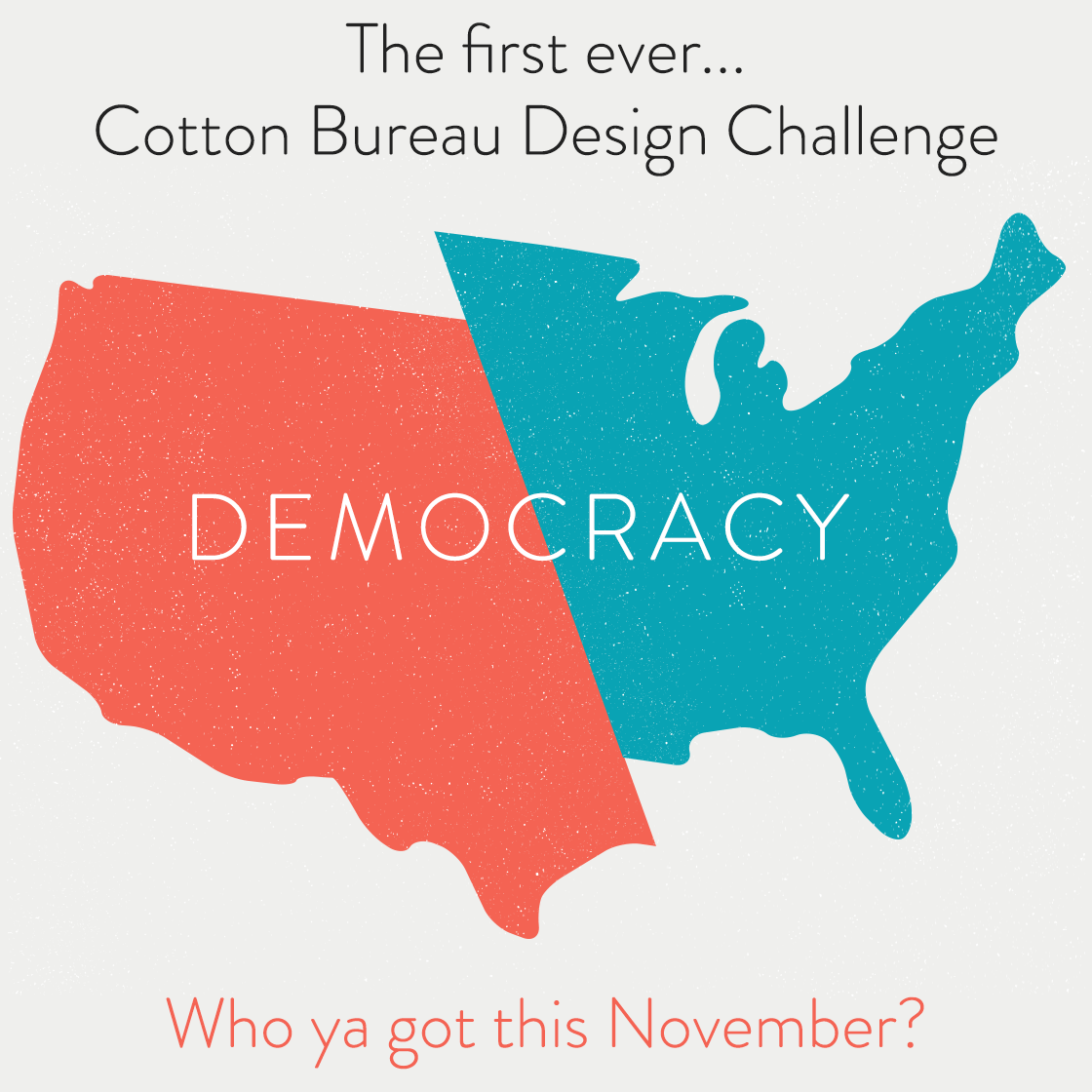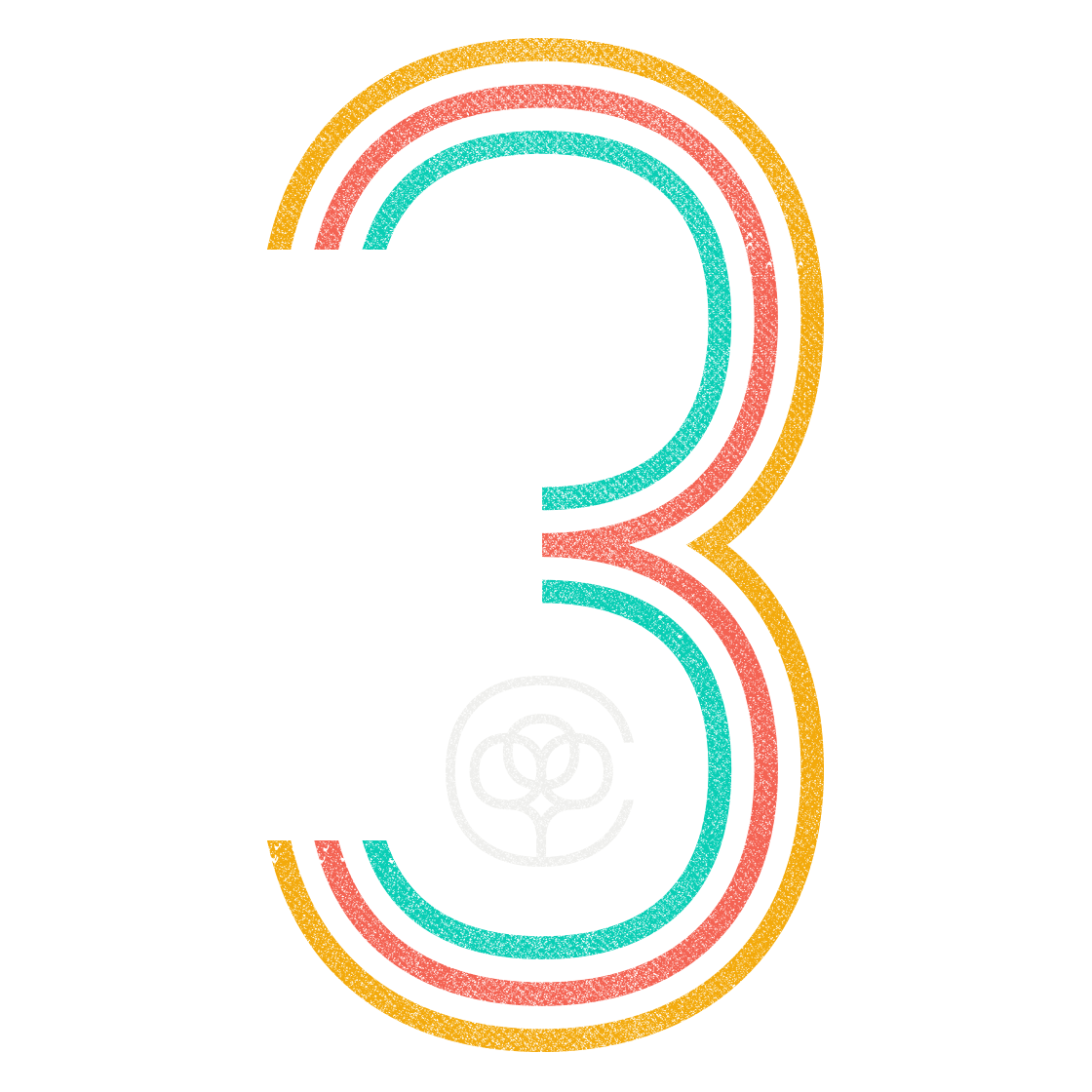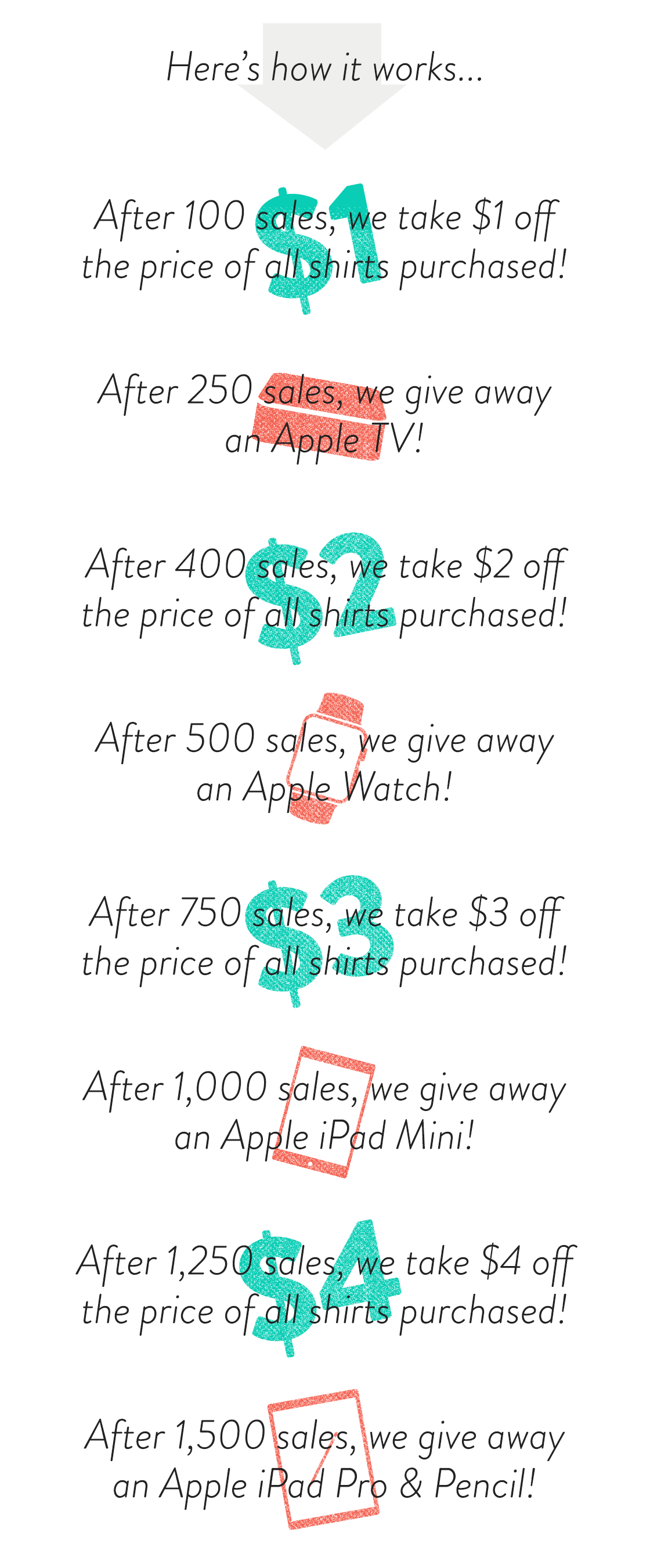I’m not sure how to tell this story other than candidly and from the beginning.
Cotton Bureau was conceived all the way back in 2011 as an extension of United Pixelworkers, a place our friends (designers and businesses alike) could sell high-quality, well-designed t-shirts on a pre-order basis just like we did. At the time we were too busy building websites for paying clients to start yet another side project, but we finally hinted at the possibility at the bottom of a lengthy blog post in early 2013. People were interested. We decided to go ahead and build the world’s most minimally viable ecommerce site. Cotton Bureau offically launched in July 2013. Submissions were entirely by email, we sold nothing but t-shirts, and you could only support one design per transaction. It wasn’t so much a store as a t-shirt crowdfunding site that had more than a little in common with Kickstarter. At the time, Cotton Bureau was just one business of a three-headed monster which included our web design shop Full Stop Interactive and our imaginary digital labor collective slash lifestyle brand, United Pixelworkers. We were content to let it grow at its own pace.
That all changed November 2013. We had cleared the decks internally for a large client project we were anticipating. Out of nowhere, it fell through. While it certainly wasn’t the end of the world, it felt like a sign. We were always extremely selective with our clients, yet, at the end of the day, they were still clients which left them perfectly capable of dropping the ball after we handed it off. We were also tired of the grind of winning a job, engaging in discovery and design, building, and launching. What if we could work on the same website for long enough to start making iterative improvements and measuring the impact of our decisions? One of the companies we most admired had switched from client services to products once upon a time. Why couldn’t we? So we did.
That left us in an exciting but precarious position. We needed more money to meet payroll than we were bringing in. Let me quote from our farewell letter:
The decision to walk away from lucrative client work is difficult, to say the least. Our products don’t make enough to completely support us. We think they can, but the only way to know is to try. In many ways, we’re right back where we were four years ago when we started the company: jumping from a precipice, hoping we sprout wings before we hit the ground. It’s thrilling, but we know that there’s a fine line between thrill and abject terror.
It’s right about the time you’re paying yourself well below market salary and aren’t sure you’ll even be able to do that next week that you begin asking yourself the VC question. We knew Cotton Bureau had big time potential. The idea was solid, we had more than enough traction, and there were others in our space who had already raised. When you’ve got kids at home or your spouse is laid off or you know you could walk away tomorrow and double your salary, it’s, shall we say, challenging to stick to the plan. We reminded ourselves that we were working to build something that lasts, something that reflected our values rather than abandoned them, something in which we could *all* take pride.
For the next three years we worked steadily to realize that vision. We shuttered United Pixelworkers to dedicate more time to Cotton Bureau. We hired. Then we hired again and again. We rejected the predominant mode of startups and startup culture. We were (and are) on Team Cameron. We didn’t want to run a race where the predetermined outcome was to get big or die trying. We said repeatedly that we wanted to remain independent and run our business in a way that took all stakeholders into consideration, not just the ones with the most money.
I’d like to quote from one of our many statements on running an independent business. This is from our soliloquy “Selling Out”:
Here’s the truth: Cotton Bureau has never sought or accepted outside investment. We didn’t set out to grow fast and flip the company for a quick profit. We’ve earnestly and frankly laid out our motivations before you. We can’t promise they’ll never change. Ultimately, we — like you — have to do what is best for ourselves. We trust that the business model we created is sustainable, fulfilling, and fair to everyone involved. After all, we agree with Cabel: maybe this is the best time of our lives.
For three years we did that. We proved to ourselves that Cotton Bureau could exist and thrive as a small business amidst both well-funded startups that are growing as fast (or faster) than humanly possible and entrenched incumbents who have all the advantages (and disadvantages) that come from decades-long legacies.
Then something changed. Last week, we concluded an agreement to accept a small cash injection from some new friends of ours. We want to tell you why and what we think it means for us (and you) going forward.
Why now?
First, we’re not desperate. Cotton Bureau is in a healthier place today financially than it has ever been. Revenue for the first half of 2016 was 40% higher than the previous six months, and we expect the rest of 2016 to be even better. Still, after three years, the list of things we want to do is so much longer than the list of things that we have been able to do. It will take us 10 years to complete our development roadmap at our current pace. We don’t want to wait.
Second, bootstrapping a business is like starting a fire by rubbing two sticks together. Through sheer effort, we coaxed an ember into existence. We laid it in the fluffiest nest of tinder and breathed on it gently until the tiniest of flames emerged. Even now, the kindling is barely lit. The success or failure of this fire requires our constant vigilance. We want to fuel this fire not nurse it. Locking in the value we’ve spent the last three years generating gives us the financial flexibility and resilience we need to do just that.
Third, we found Indie.vc.
Why Indie.vc?
Indie.vc was first announced January 2015. Cotton Bureau was 18 months old at the time. We had just closed United Pixelworkers. Every decision we made had to be measured in terms of its effect on our week-to-week cashflow. Was the precise thing we were working on worth our time and effort? If we ran an ad, would it make back the spend and then some? Could we find someone willing to work part-time?
For years we had been looking to obtain a line of credit from a bank to give ourselves some breathing room. Each time, however, they made up a new and more ridiculous reason why we couldn’t qualify. (Actually these were probably completely rational reasons from the habitually risk averse banks’ point of view, but compared to the more aggressive nature of internet businesses, they seemed maddeningly short-sighted to us.) We considered trying a small business loan, but we didn’t have a large capital expense or an obvious way to immediately recoup the money.
As you can tell, outside investment was definitely not our first choice. We reluctantly decided to have a few conversations with friends and investors during this time just to make sure we weren’t missing an opportunity out of ignorance, but it only confirmed what we already knew: when you get in bed with a VC, that’s not a decision you can unmake. You had better be sure that’s what you both want.
The good news was that revenue at the time was climbing consistently month-over-month, and we were now working full-time on Cotton Bureau. The bad news was that we were still just barely scraping by personally and as a business. When we saw the Indie.vc announcement and the follow-up discussion on Hacker News, we were intrigued. It probably goes without saying (again), but we hang our collective hat on a certain stubborn independence. If we’re not free to make decisions consistent with our values, we’re not interested. Now here was someone offering money and support with the explicit premise that independence was a virtue and should be guaranteed.
Bryce, the creator and director of Indie.vc, even wrote up some principles that might as well have been hanging on our office walls in his post “Drafting a Declaration of Independents”:
* Independent businesses are majority owned by their Founders.
* Founders should maintain full voting control of their board of directors.
* Independent businesses should provide equity or equity-like profit sharing to all employees that should be reported in percentage of company/profits vs. number of shares.
* Independent businesses provide a real time view into companies financials and make that available to all employees.
* Independent businesses should provide the same level of benefits for all employees as they do for their Founders.
* Independent businesses respect their users by not selling their data to 3rd parties or opting them into spammy offers.
* Independent businesses, who’ve raised outside capital, put in place a distribution plan for their investors to share profits and relieve pressure to go public or sell out.
Where do we sign?
Along with 500 or so other applicants, we threw our hats in the ring. We reserved the right to decline any offers we might receive, but we felt obligated to at least see how the process played out. Fast forward a few weeks or months, and we were on the short list. Except… it didn’t happen. Bryce and his team rightly concluded that while our core business was strong, the amount of money being invested was unlikely to move the needle for us, particularly without a firm plan for how to spend the money. We were inclined to agree. Indie.vc decided to invest in some other companies instead. Still, we kept in touch and even bumped into each other at XOXO last year in Portland. If there’s one thing I’ve learned to embrace in the past seven years of running a business, it’s valuing people and relationships as highly or even more highly than product. None of our businesses would have succeeded without the kind words and deeds of others. Doors close in your face all the time. Don’t burn the house down out of spite.
A little more than a year after the original round launched, Indie.vc announced that they would be opening a second round of investments, this time with a higher cap. After a brief discussion internally it was agreed that we would try again. Revenues were up significantly year-over-year, but that didn’t alleviate our frustration with being cash-strapped. So many ideas, so little disposable income. Some ideas were big, some were little, very few if any could be realized without severely straining our resources. We contacted Bryce and suggested Indie.vc might want to take another look at Cotton Bureau. That email set in motion a chain of events that culminated in Indie.vc investing the full amount available for an individual company under the terms of their current round. It’s not a huge number by Silicon Valley standards, but it’s a radical change for an independent company with revenues that exceed costs. When you have a negative burn rate, it doesn’t take multi-million dollar investments to unlock substantial possibilities.
A Good Endeavor
That more or less concludes our story for today. It’s a good day, and we’re excited. We had our celebratory office donuts yesterday, and while it’s neither the end nor the beginning of the story, we think it’s a good time to remind ourselves of the help we’ve had along the way. We would like to offer a public acknowledgement and thank you to our partners and families for their patience and support the last seven years as we felt our way along this path. We would also like to thank a handful of friends in the industry who were considerate enough to lend us their time in answering our questions about their experiences with business and outside investors including (but not limited to) Dave Pell, Mike Davidson, Sean Ammirati, Ned Renzi, Stephan Ango, Matt Alexander, Matt Haughey, Derek Powazek, and Heather Champ. We can’t do justice to their contributions in this limited space. Finally we need to thank each person who has bought or designed a shirt and especially the people who have chosen to entrust their livelihoods into our hands. Cotton Bureau doesn’t exist without you.
Let us leave you with this: Cotton Bureau is a company of people from different backgrounds, in different situations, with different beliefs. We don’t agree all the time. In fact, we disagree a lot. If you’ve seen Jay and I speak at a conference before, you’ll know our differences run wide and deep. If you visited the office, you’d often find us in a heated debate on what is right and good. Where we agree is in having a shared understanding of the value of a job well done, in our insistence that work provide not just money but meaning, in our concern for fairness and empathy in the relationships we build with one another, with our vendors, our partners, our customers, and, now, our investors. We believe an independent Cotton Bureau can do great things. We’re thankful Indie.vc shares that vision.
The following are some questions you might or might not have.
How will Indie.vc support and empower Cotton Bureau to fulfill its goals as a company?
We’ve stated publicly that “success for us is building a sustainable company that helps designers and communities meet their financial, practical, and creative needs.” There’s no question in our minds that aligning ourselves with Indie.vc is going to advance that mission. Working together gives us access to more resources without compromising our principles or the financial integrity of the company.
What are you going to do with the money?
We’re going to spend it. We’ll have more on that soon. If you’ve been paying attention, though, you might be able to guess one of our highest priorities.
Does this make it more likely that Cotton Bureau will raise additional money or be acquired in the future?
More likely? Yes. Likely? Not necessarily. If either of those events ever takes places, we would like to think our approach will involve the same cost-benefit analysis that led to this decision. How does the proposed event help or hinder our stated corporate goals?
Are you hiring?
Yes, we are. Thank you for asking. We’ll have more details on that next week, but we are specifically looking to hire a designer and a developer. If you’re considering applying, please know that you need to be good at those things. Designers are expected to be sufficiently well-versed in HTML and CSS to be able to execute their designs in the browser. Developers should have a functional grasp of both front-end and back-end technologies. You can email us@cottonbureau.com if you’re interested. We’ll have full job descriptions available next week along with some thoughts on hiring in general.
Are you moving?
No, we are not moving. We’ll be staying right here in sunny Pittsburgh.





